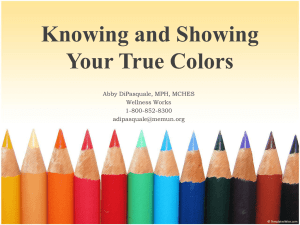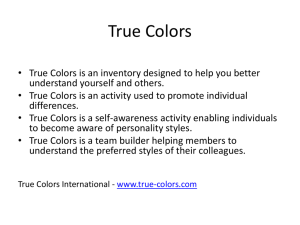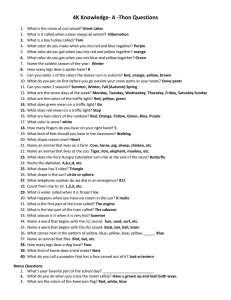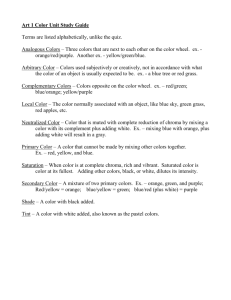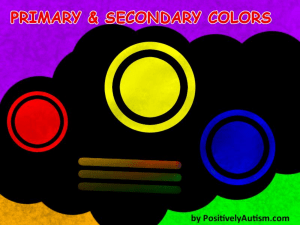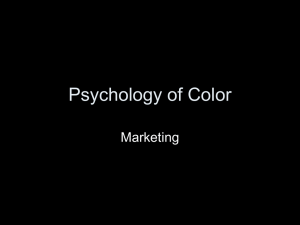True Colors
advertisement
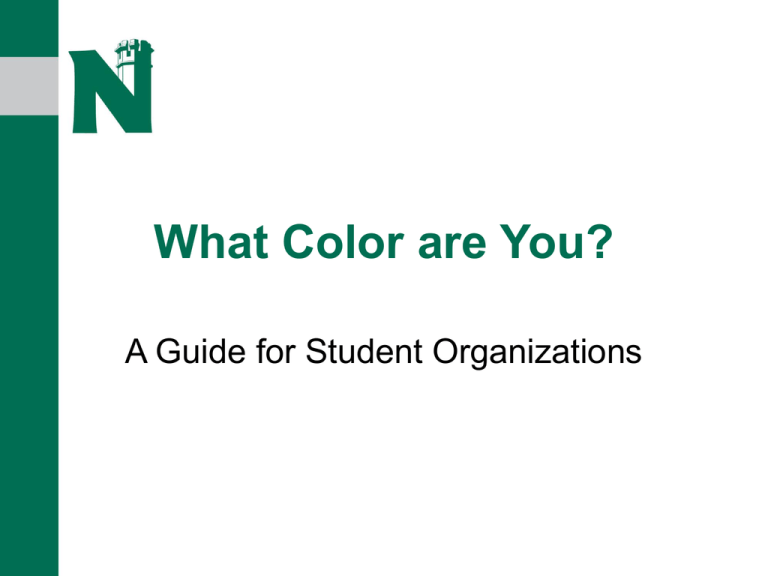
What Color are You? A Guide for Student Organizations Behaviors that lead to trust • • • • • • • Talk straight Demonstrate respect Create transparency Right wrongs Show loyalty Deliver results Get better • • • • • • Confront reality Clarify expectations Practice accountability Listen first Keep commitments Extend trust Assume Good Intent True Colors • Inventory designed to help you better understand yourself and others. • Activity used to promote individual differences. • A self-awareness activity enabling individuals to become aware of personality styles. • A team builder helping members to understand the preferred styles of people they work with. True Colors • Each color is reflective of your personality. • You will identify a primary and a secondary color. These are your preferred styles. • The colors you do not choose will have some characteristics that are representative of you; however, it is not your preferred style. • True colors is valuable for improving your effectiveness in working with others. What Color Are You? • Rank each set of word clusters in each row from 1 to 4 • Once you have them ranked, total your answers at the bottom. • The color with the highest score is your primary color • The color with the second highest score is your secondary color • If you have a tie for either, choose the one with which you most identify Divide Into Color Groups Green: Northeast Corner Gold: Middle of the room Blue: Southeast Corner Orange: Southwest Corner In Your Color Groups • Discuss your color group’s best traits • Discuss your color group’s challenge areas. • Choose a spokesperson to share the top 3 of each. Green See Self • Superior intellect • 98% right • Tough-minded • Efficient, powerful • Original and unique • Rational • Great planner • Calm not emotional • Precise not repetitive • Under control • Able to find flaws objectively • Holding firm to policy Others See • Intellectual snob • Arrogant • Afraid to open up • Unappreciative, • Stingy with praise • Doesn’t consider people in plans • Critical, fault-finding • Cool, aloof, unfeeling • Eccentric, weird How to Work with Greens •Be aware of their curiosity about life •Give things that challenge their problem-solving abilities •Respect their need for independence •Know they are caring even though they may not show it •Respect their inventions and ideas •Give them time to process information Gold See Self Others See • • • • • • • • • • • • • • • • • • • • • • • Stable Providing security Dependable Firm Always have a view Efficient Realistic Decisive Executive type Good planner Orderly, neat Punctual, expect same Rigid Controlling, bossy Dull, boring Stubborn, pigheaded Opinionated System-bound Unimaginative Limiting flexibility Uptight Sets own agenda Rigid idea of time How to Work with Golds •Remember to be on time •Try to be extra organized and efficient •They are generous but like things returned •Do what you say you will do •Be dependable, loyal •Respect their need for security See Self Blue • Warm, caring, compassionate • Likes to please people • Trusting • Romantic • Spiritual • Creative • Idealistic • People person • Willing to work tirelessly for a cause • Unselfish • Empathetic • Wanting harmony Others See • • • • • • • • • • • • Overemotional Groveling, fawning, soft Too trusting Mushy Hopelessly naïve Too nice Aloof Smothering Manipulative Ignores policy, create chaos Talks too much Illogical, incomprehensive How to Work with Blues •Spend quality time one-on-one with them •Be aware they wear their heart on their sleeve •Listen to them as they listen to you •Be supportive •Share your thoughts and feelings •Praise their imagination and creativity See Self • • • • • • • • • • • • Orange Fun loving, enjoys life Spontaneous Flexible, adaptable Carefree Proficient, capable Hands on person Practical Problem solver Good negotiator Here and now person Does many things at once Eclectic Others See • • • • • • • • • • • Irresponsible Flaky Wish-washy Not serious Spends time on things they enjoy Not interested in ideas Disobey rules Manipulative, not to be trusted Not able to stay on task Cluttered Indecisive How to Work with Oranges • Be active with them, don’t slow them down • Be spontaneous and fun, not a heavy • Compete in fun when appropriate • Be adventuresome and optimistic • Be energetic and ready to go In a nutshell… Green – “Why?” Gold – “Be Prepared” Blue – “How does that make you feel?” Orange – “Just do it” Percentages of Population by Leadership Style Green 10-13% Gold 33-50% Orange 12-33% Blue 12-25% How is this Applicable to you? • • • • • How we work with each other How we communicate with each other Office time Events Others? Have you ever… • Encountered that one person with whom you just couldn’t communicate? • Had days when you felt like you were speaking a foreign language and no one else could understand what you were saying? • Tried to communicate with a person, with whom you normally communicate well, but couldn’t get them to see your side? Consider this… • Each person approaches projects and conversations differently. • Most people approach professional life differently than personal life. • Sometimes, understanding how you may be perceived can help you understand how to better communicate. Don Lowry, creator of True Colors “Successful people know who they are and what their True Colors are… when you know what your core values and needs are and feel good about them, you can perform at your highest potential in every area of life. And when you share a working, mutual understanding of other’ core values and needs, you have the basis to communicate, motivate, and achieve common goals with utmost dignity, efficacy, and mutual respect.” Conclusion • Everyone has some of each color. • We each have our strengths and our weaknesses. • Try to play to each others strengths and consider how others approach ideas, projects, and communication. • Use this information to become a better communicator and team player. Assume Good Intent
